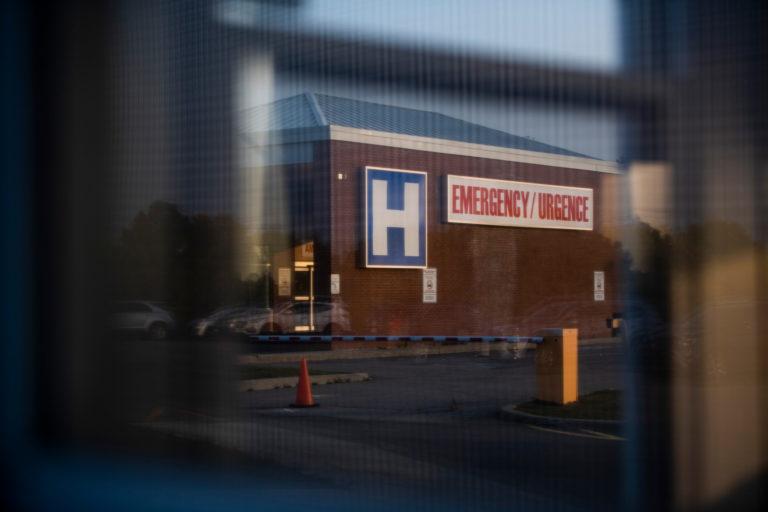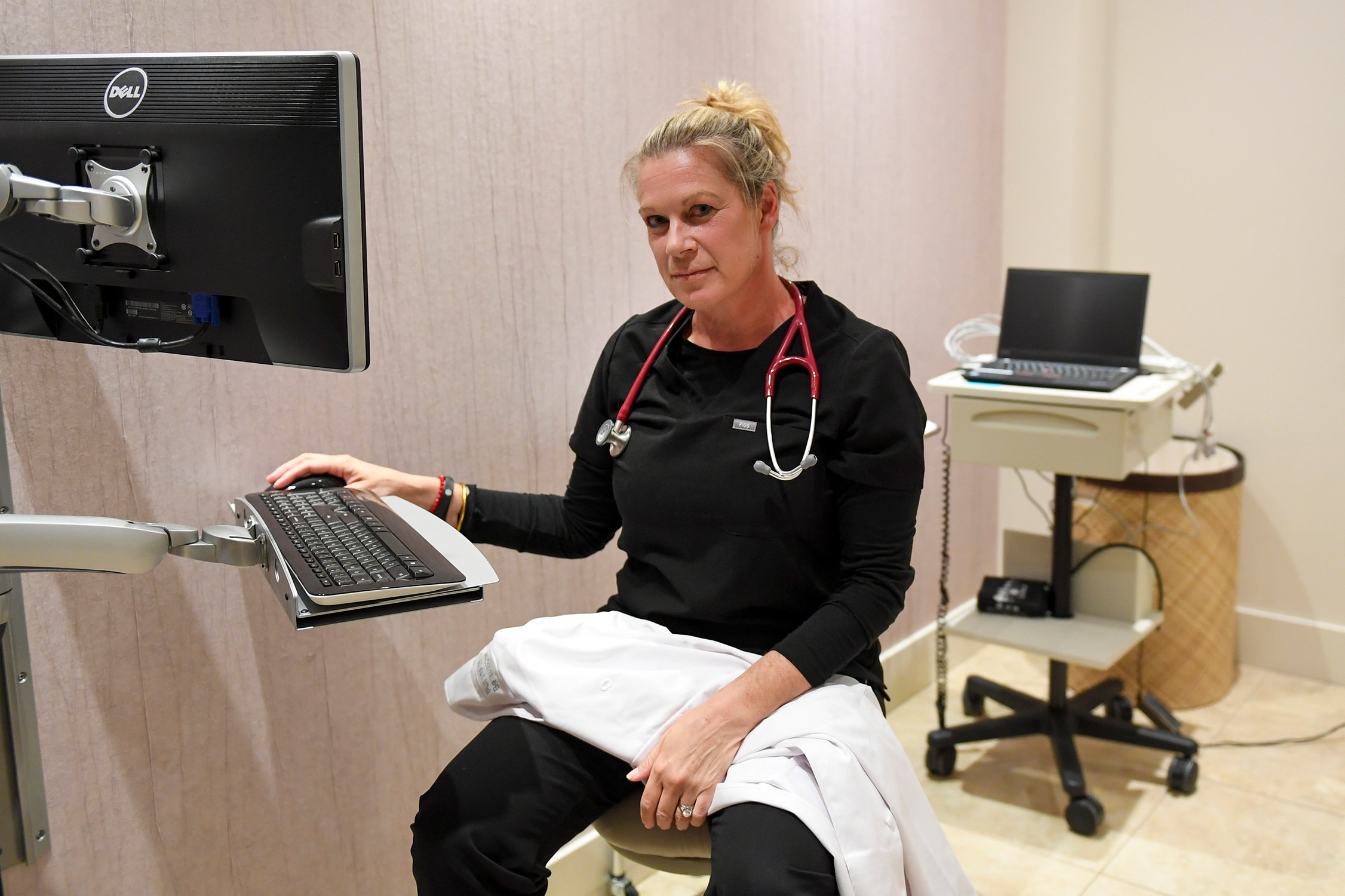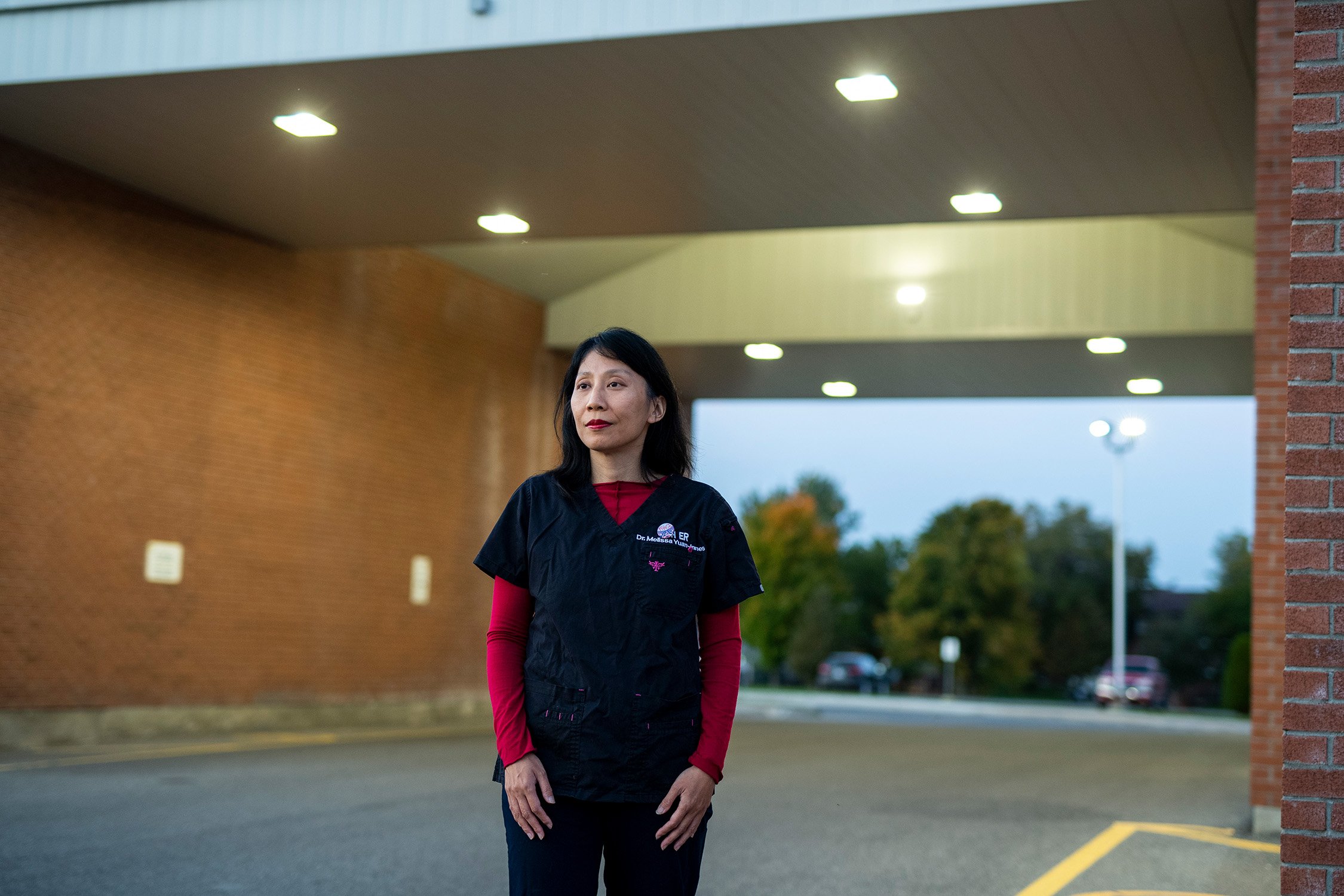The gruesome killing of an Alberta GP puts a spotlight on physician abuse
Walter Reynolds was bludgeoned to death by a patient, shocking Canada’s medical community and prompting physicians to share their own dangerous brushes with abuse

Many doctors feel they must respect patients’ privacy—even at the cost of their own safety (Photograph by Justin Tang)
Share

When Kathryn Dundas was a young physician working emergency room shifts, she would sometimes spot her stalker sitting in his car in the small-town hospital parking lot. Watching. He parked just far enough away to avoid violating a peace bond Dundas had obtained after the man, a former patient, threatened to kill her. At five feet, eight inches and 135 lb., Dundas had been captain of her varsity basketball team and considered herself strong and athletic. But being stalked made her feel acutely vulnerable. “You start to think you are overreacting and try to play it down to keep yourself sane,” she says. “It is a vicious circle of feelings; you have no control over what may happen to you and your family.”
The man’s rage had been triggered by Dundas’s refusal to prescribe him a narcotic and her subsequent efforts to drop him as a patient after he screamed obscenities at her during office visits. She was practising at the time in the only medical clinic of a southern Alberta town while serving as head of emergency at the local hospital, so she had effectively blocked his legal access to drugs. “I became the person who wrecked his life,” she recalls.
The death threat, when it came, was made to a third party in the community who took it so seriously they phoned the police. Officers were sympathetic, but also realistic. Her stalker was a violent drug user, previously charged with a homicide. A peace bond would do little to keep her safe on nights when she was alone at home on a country road. “I was told to get a dog. I was told to learn how to shoot a gun,” Dundas says. She adopted a shepherd-Akita cross named Rocky and began to bring him everywhere—even to the hospital and her clinic. Soon after, she got her firearms licence.

Finally, Dundas confided her fears to her father, a respected Calgary pediatrician. She had followed his footsteps into medicine, believing her own career would mirror his experience of serving appreciative patients who sent him home at Christmas with Greek shortbread cookies and fruitcakes. Terrified for his daughter’s safety, Dundas’s father hired two former homicide detectives to protect her. They identified safety weaknesses in her home and at the clinic and hospital, including the code to the hospital staff door mistakenly being published online. For six months, “they basically stalked my stalker,” she says. Finally, the two ex-cops “gently prodded” the man to leave town.
Like many family doctors, Dundas has faced numerous abusive incidents over the course of her career, memories of which came flooding back last summer when they learned of the grisly murder of Walter Reynolds, a family physician in Red Deer, Alta. The 43-year-old family practitioner was bludgeoned to death on Aug. 10 inside an examination room, allegedly by a patient wielding a hammer and machete. Police say the murder was premeditated; Deng Mabiour, 54, of Red Deer is charged with first-degree murder and assaulting another doctor and a police officer at the scene. Mabiour appeared to have severe mental health problems, according to media reports; he was described as a loner who talked to almost no one and was often seen wandering Red Deer’s streets, sifting through garbage bins.
READ: Portraits of B.C.’s pandemic frontline health care workers
The killing so shocked Canada’s medical community that physicians began to share stories on private Facebook feeds about attacks and abuse they have endured. Some of the anecdotes were provided to Maclean’s with names of physicians and patients redacted. “I refused narcotics to a patient in a rural [emergency department]—he leapt off the bed and reached for my neck, trying to strangle me,” one physician wrote. Another said: “Worked in a rural family medicine clinic and refused to prescribe [the opioid] Dilaudid. The patient said he and his posse were going to come to my house later and make me pay. Slept with a chair jammed against the bedroom door, a knife under my pillow and 911 on speed-dial for the rest of the week.”
While violence directed at nurses, care aides and other health-care workers is well documented and publicized, abuse of physicians is not. All health-care professionals are sworn to protect patient confidentiality, but doctors don’t have unions to publicly raise their concerns, and few speak about their experiences. The culture of silence begins when they enter medical school, where their training is informed by the Hippocratic oath—most schools still demand that students formally swear to uphold it. A key tenet states, “I will respect the privacy of my patients, for their problems are not disclosed to me that the world may know.” When doctors are yelled at, punched, spat upon or threatened by a patient, they often tell no one outside of family members or office colleagues. “In general, we feel like patient concerns always trump us,” says Melissa Yuan-Innes, an emergency room physician working in Alexandria, Ont., “even at the cost of our own safety.”
Yuan-Innes was horrified by the murder of Reynolds and, after reading the deluge of stories on Facebook, was stirred to speak publicly about physician safety on behalf of her colleagues. “We just feel abandoned,” she says. Yuan-Innes believes she’s been comparatively lucky: “I try to duck the biting and spitting,” she says, but adds that swearing and racial epithets are common. “Once a patient smacked my rear end. Another tried to kick me, but a nurse had warned me [the kick was coming] and I dodged it.”

Many of her colleagues have experienced worse, and that knowledge puts a person on edge, she says. Years ago, when she was pregnant, an orderly warned Yuan-Innes that abusive patients had been known to punch or kick the abdomens of female doctors carrying children. So she stopped scheduling shifts after her second trimester, accepting the resulting financial hit.
Doctors who are pushed to the brink and decide to drop an abusive patient typically seek advice from their medical associations, their provincial colleges of physicians and surgeons that regulate their profession, and the federal insurer, the Canadian Medical Protective Association (CMPA). However, rules set up by these organizations are also guided by the Hippocratic oath and designed with patients’ interests at the fore. College rules are modelled after the Canadian Medical Association’s code of ethics, which states that once a doctor assumes care of a patient, they must continue to provide medical services until the patient no longer wants or needs it. If a physician wants to “divorce” or “fire” a patient, as it’s known in medical parlance, they are expected to continue treatment “until another suitable physician has assumed responsibility for the patient, or until after the patient has been given reasonable notice that you intend to terminate the relationship.”
Colleges require heavy documentation outlining the abuse and the doctor’s efforts to resolve the conflict. And reasonable notice is typically interpreted as 30 days, during which physicians are expected to help their patient find alternate care—which, in a small community with few medical services, is not always possible. In those cases, that can mean continuing emergency treatment for a month, even after a violent incident. “Even if it puts you in danger,” says Yuan-Innes, “they still say this is your obligation.”
That the murder of Reynolds has heightened doctors’ safety concerns is understandable, says Dr. Todd Watkins, associate executive director with the CMPA: “When a tragic event like this happens, it puts a fine point on it.” His organization has a team of 45 advisers who field 200 calls a day from physicians seeking medical and legal advice. Many come from doctors seeking to divorce a patient who needs help working through their “duty of care,” Watkins says.
READ: Forget about our ‘lanes.’ It’s time for doctors to flood the freeways.
Those ground rules are set by the provincial regulatory colleges and differ slightly province to province. And while physicians may believe otherwise, Watkins says, he isn’t aware of any province that requires a physician to continue treating an abusive or violent person through the 30-day notice period, except in an emergency. “They’re not obligated to see the patient, but there is some obligation to direct them to the appropriate care, to ensure the patient is not harmed,” he says. Watkins concedes that can be a problem in tiny communities where a physician may be the only option in town for primary and emergency care: “If you determine the relationship has dissolved and, later that day, the patient comes into emergency with chest pains and you’re on call, there is still an expectation that you would look after that patient.”
Watkins also rejects the notion that the confidentiality oath trumps doctor safety, characterizing it as a misperception: “Physicians are absolutely allowed to call police if they are threatened.” A 1999 Supreme Court of Canada decision, Smith v. Jones, ruled patient confidentiality can be breached where the threat is serious and poses a risk to an identifiable party.
Yet many physicians taking part in the Facebook discussions report being told by the CMPA to “just call us; don’t call the police,” Yuan-Innes notes. Watkins says that’s possible in some instances; each case must be judged on its own merit when deciding whether a threat is serious enough to warrant breaching confidentiality. “There are no easy answers. If a patient says, ‘I’m going to hurt you,’ that’s clear,” he says. But, he adds, if a patient makes a veiled threat or doesn’t clearly identify who will suffer harm, the law sides with confidentiality.
Even in clear-cut cases, physicians may hesitate to tell anyone because they fear the patient will complain to the college, says a physician who was assaulted during her residency in northern B.C. “There’s this culture of acceptance, this culture of being afraid to make a complaint or ask for help because we could lose our licence to practise medicine.”
She spoke on condition of anonymity because the community was so tiny that disclosing details could identify the patient. The attack happened a decade ago in the walk-in area of a cramped emergency bay when the girlfriend of a patient grew irate over the long wait, and snapped when she saw the doctor. “She had a glass bottle she was beating me with and tried to choke me with my stethoscope,” the physician recalls. At five feet, ten inches, the doctor was taller than her attacker. “But I felt I couldn’t fight back,” she recalls, “that I’d get in trouble.” The physician yelled for help to no avail. When the attack ended, the physician asked the nurse to call the police. They discovered a security camera in the waiting area had recorded the incident. “It was all on video, thank God. Because nobody else came to witness.”
[contextly_auto_sidebar]
The doctor was left with bruises and never felt safe after that; the community was so small that everyone knew where she lived. “The cops told me to get a bat and bear spray,” she says. “I stayed for a little bit, but I couldn’t sleep.” Soon after, the residency program in that community was disbanded.
Despite the litany of horror stories, there are few studies quantifying the extent of violence and abuse faced by doctors, and those that exist are dated. In 2010, the International Journal of Family Medicine published a study examining the monthly incidence rates of abusive encounters reported by family physicians in Canada. Fully 29 per cent of respondents had experienced a major instance of abuse (smashing of objects, property destruction or sexual harassment) or a severe one (assault, sexual assault or stalking) inflicted by a patient or a patient’s family member in the last month. Most were unaware of policies to protect them, and the vast majority—76 per cent—did not seek help. There is some evidence that, in recent years, the problem has been linked to prescription drug abuse.
In 2014, Canadian Family Physician published results of a study of abuse by patients seeking controlled substances. Some 95 per cent of 178 doctors who participated, mainly family physicians in Nova Scotia, reported at least one incident of minor abuse, such as bullying, threats or verbal humiliation, over the course of their careers. Almost half, 48 per cent, had experienced one incident of major abuse; another 17 per cent reported they had once been severely abused. Watkins says the situation might have worsened over the last two years as doctors enacted directives to vastly reduce the number of opioids they prescribe. But no one has studied it recently on a national scale.
Dr. Ann Collins, Canada’s newly appointed president of the Canadian Medical Association (CMA), notes that physicians are regulated provincially, and there is no single repository of national statistics. “But one of the things we know intuitively,” she adds, “is that the incidence of abuse, whether it be physical or verbal, is vastly under-reported.” Last year, the CMA, the national organization that advocates for physicians on health matters, raised the issue of violence against all health-care workers with the federal Standing Committee on Health. Despite limited data on the problem, the CMA wrote in a letter to the committee, “anecdotal evidence suggests that these experiences are increasing in frequency and severity.”
The association recommended making assault on health-care workers performing their duties a separate Criminal Code offence. It also requested funding for nationwide research to identify workplace violence trends and a national prevention strategy. So far, there has been no movement from Ottawa, Collins says. Last month, the CMA launched an online wellness hub, linking doctors to hundreds of resource sites with information on topics like burnout, depression, mental health and wellness.
One of the links points to a violence prevention guide designed by the Doctors of BC, the provincial medical association, instructing community practitioners how to stay safe on the job. It addresses, among other things, clinic design: gold-standard examination rooms have panic buttons and two exits so a physician can get out in a hurry. Doctors working in rooms with only one door are taught safety techniques, like leaving the door open and positioning themselves between the patient and the exit.
Dr. Kathleen Ross, the president of Doctors of BC, learned that lesson herself—the hard way. After the murder of Reynolds, she shared her own terrifyingly close call in a blog post. Near the end of the day about 15 years ago, a long-standing patient brought a relative in a state of deep distress to her clinic. “The patient was behaving strangely, and the family was worried,” Ross wrote. She agreed to see the man, and once in the examination room, sat on a stool at the end of her exam table to give him room to pace.
When he finally met her eye, a shot of fear ran through her. “The expression was unlike anything I had seen in my career to date, or since,” she recalled in the post. “His eyes appeared wholly black, endlessly deep and yet keenly focused on mine.” When he began to calmly answer her questions, she knew her fears were justified. “Yes, I am restless,” he told her. “I cannot stop the thoughts in my head that I need to kill my family. I just need to hurt someone.” It was then she noticed her patient was standing squarely between her and the door. She remained calm, asking him ever so politely to excuse her for a moment to take a call. To her relief, he stepped aside. She’s kept her back to the door ever since.
Other doctors aren’t wary or lucky enough to spot the danger in time. In 2019, a Sherbrooke, Que., psychiatrist was punched in the face until he lost consciousness by a patient who was charged with aggravated assault. The same year, a Hamilton, Ont., physician was stabbed multiple times in the hand and torso by a man who entered his east Mountain medical clinic with a knife. The attacker was subdued by others in the clinic and the doctor survived.
Ross says more education is needed so doctors aren’t forced to learn on the fly how to keep themselves safe. B.C.’s 2019 master agreement between the provincial government and doctors added physicians to a plan to improve safety for unionized health employees. It includes a commitment to develop violence prevention and response training for all physicians. Ross is proud of the progress being made. “Occupational standards are [supposed to] apply to all workers in Canada. This is the first time they’ve truly been applied to physician issues.”
It’s a complex issue because, while family doctors are publicly funded, they deliver services as private entities, typically in their own offices, Ross says. They bear costs associated with safety training, time off after a traumatic event, and office design themselves. Dundas notes that the Alberta Medical Association allows members to write off expenses against their association dues for conference fees and technology expenses. She would like to see a similar provision for staff training and office safety improvements. “Most of what I learned, I had to go elsewhere to learn it and then try to teach my staff,” she says.
Ross believes step one to mitigating the violence and abuse faced by physicians is to acknowledge the problem exists. Acts of extreme violence like the murder of Walter Reynolds are rare, but not unique, she says, adding: “The everyday aggression and risks all health-care workers face—we really don’t emphasize that enough.”
This article appears in print in the November 2020 issue of Maclean’s magazine with the headline, “Physician, shield thyself.” Subscribe to the monthly print magazine here.